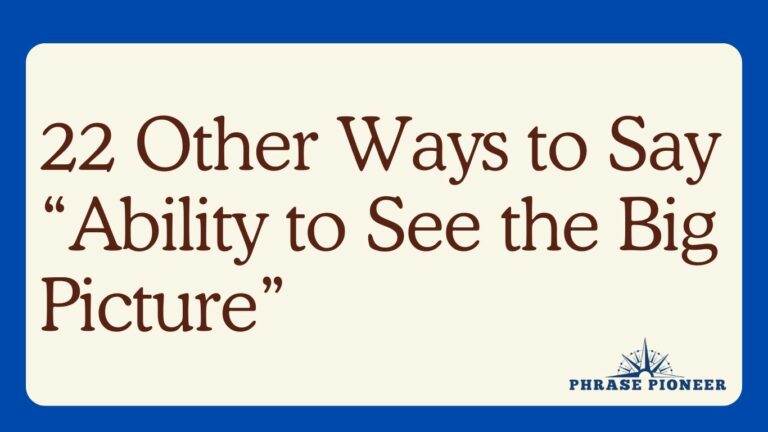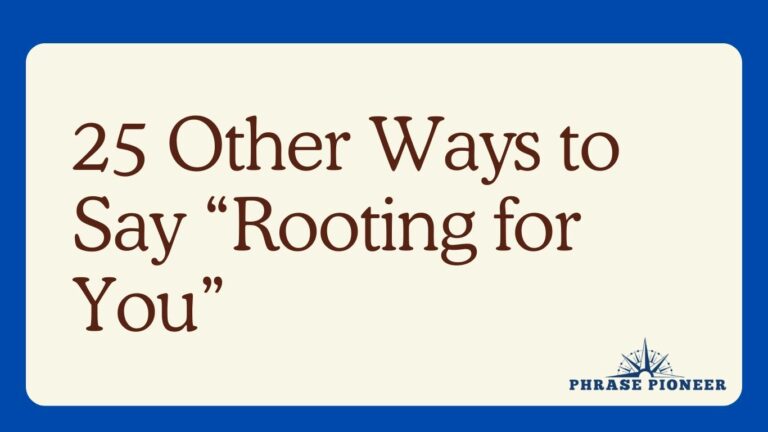30 Other Ways to Say “Having Said That”
When transitioning between contrasting points or adding a caveat to a previous statement, the phrase “having said that” is an essential linguistic pivot.
This connector acknowledges what has been mentioned, while also implying a reconsideration or contrasting viewpoint.
However, its frequent use can become monotonous. Here are 30 alternative phrases to transition smoothly between ideas, offering variety and depth to your conversations and writing.
Transitional Phrases
- Nevertheless
- Explanation: Despite what has just been mentioned, there is another significant point to consider.
- Example: “Their proposal was the most detailed; nevertheless, we must consider the cost efficiency.”
- However
- Explanation: Introduces a contrast or exception to the previously mentioned point.
- Example: “The weather was gloomy; however, we decided to proceed with the picnic.”
- Nonetheless
- Explanation: Indicates that despite the prior point, another statement holds true.
- Example: “He was inexperienced, but nonetheless, he proved to be a valuable team member.”
- Even so
- Explanation: Another fact or argument is presented despite the previous statement.
- Example: “The documentary was factual. Even so, some viewers found it biased.”
- That said
- Explanation: Similar to “having said that,” indicating a shift to another perspective.
- Example: “We had some struggles with the project. That said, the outcome was impressive.”
- On the other hand
- Explanation: Marks the introduction of an opposing viewpoint to what was just mentioned.
- Example: “She is a talented painter. On the other hand, her brother excels in sculpture.”
- Conversely
- Explanation: Introduces a contrasting point of view or circumstance.
- Example: “The north region is experiencing a drought; conversely, the south is dealing with floods.”
- Yet
- Explanation: Serves as a conjunction connecting two contrasting ideas.
- Example: “She practiced for weeks, yet her performance did not go as planned.”
- Then again
- Explanation: Suggests a reconsideration or additional thought.
- Example: “The test results were satisfactory. Then again, there’s always room for improvement.”
- At the same time
- Explanation: Recognizes two ideas or situations occurring concurrently but possibly in opposition.
- Example: “The new design is innovative; at the same time, it might be too advanced for some users.”
- Still
- Explanation: Maintains the previous argument but introduces a mitigating or contrary aspect.
- Example: “He agreed with the concept; still, he had doubts about its implementation.”
- Notwithstanding
- Explanation: Whatever has been said does not prevent what will be said from being true as well.
- Example: “The historical evidence is solid; notwithstanding, skeptics remain.”
- Alternatively
- Explanation: Offers another option or idea following the previous statement.
- Example: “One could use the default settings. Alternatively, customizing them may yield better results.”
- Be that as it may
- Explanation: Accepts the previous statement but maintains the position with a contrasting point.
- Example: “It’s an outdated method. Be that as it may, it has proven to be reliable.”
- In spite of that
- Explanation: Recognizes something that might have been an obstacle, yet the following point still holds.
- Example: “The market conditions were unfavorable; in spite of that, the company prospered.”
Contrasting Connectives
- By contrast
- Explanation: Contrasts two differing elements or thoughts.
- Example: “The early sales figures were disappointing; by contrast, the year-end results exceeded expectations.”
- In contrast
- Explanation: Highlights the difference or opposition between two points.
- Example: “The first edition was compact; in contrast, the second edition is much more extensive.”
- Despite this
- Explanation: Acknowledges preceding information but underscores a divergent scenario.
- Example: “The smartphone market is saturated; despite this, our product gained considerable market share.”
- All the same
- Explanation: Indicates the acknowledgment of a previous point while stating a consistent opinion.
- Example: “The critics gave it rave reviews; all the same, I didn’t enjoy the film very much.”
- With this in mind
- Explanation: Considering the information given, another aspect is brought to attention.
- Example: “He can be rather blunt; with this in mind, try not to take his comments personally.”
- Admittedly
- Explanation: Concedes a point before introducing a differing statement.
- Example: “Admittedly, the plan is high-risk, but the potential rewards are significant.”
- Counter to that
- Explanation: Introduces information or perspective in opposition to what was mentioned.
- Example: “He prefers a structured routine. Counter to that, his partner thrives on spontaneity.”
- Conversely
- Explanation: Shows an inclination towards an opposing or different viewpoint.
- Example: “Online shopping has increased. Conversely, in-store visits have declined.”
- Despite that
- Explanation: Identifies an existing factor but negates its influence on the conclusion.
- Example: “It was her first time teaching the course; despite that, the semester went smoothly.”
- This notwithstanding
- Explanation: Prior facts or statements do not diminish the validity of the argument to follow.
- Example: “The political situation is unstable, this notwithstanding, the markets have reacted calmly.”
- Albeit
- Explanation: Introduces a concession or condition within an argument.
- Example: “It’s a workable solution, albeit not a perfect one.”
- Withal
- Explanation: Indicates that something is true despite what has just been mentioned.
- Example: “The book is lengthy and complex; withal, it’s an engaging read.”
- On the flip side
- Explanation: Presents the other side of the argument or a contrasting viewpoint.
- Example: “The car is expensive to purchase; on the flip side, it’s very economical to maintain.”
- Mind you
- Explanation: A more conversational way to preface a contrasting statement.
- Example: “It’s a good product, mind you, it’s a bit overpriced.”
- Taking that into consideration
- Explanation: After considering the previous statement, a new point is weighed.
- Example: “He hasn’t been the most reliable worker; taking that into consideration, let’s give him a chance to explain.”
Conclusion
Skillfully using transitional phrases like the ones provided above can add layers of meaning and improve the flow of narrative or discussion.
Whether you’re writing an academic paper, engaging in debate, or simply having a conversation, these alternatives to “having said that” enrich your language with subtlety and engagement.
By diversifying your usage of such connectors, you ensure your communication is not just clear and effective but also dynamic and interesting.







